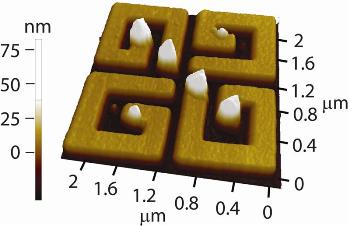Researchers of K.U.Leuven, while examining the nanomaterials’ optical properties, have discovered that surface plasmons leave behind imprints on the nanostructures’ surface. This discovery has led to the development of a high resolution microscope that is suited for imaging the nanostructures’ electric fields.
 Surface plasmon patterns can be imprinted on metallic nanostructures for subsequent high resolution imaging with standard surface probe techniques
Surface plasmon patterns can be imprinted on metallic nanostructures for subsequent high resolution imaging with standard surface probe techniques
Nanomaterials, comprising thin layers or very small particles, are likely to obtain unexpected properties. In recent years, optical nanomaterials have become a sought-after topic because of their applications and counterintuitive optical behavior. They are based on surface plasmon resonances, a property, by which light can excite surface electron waves collectively in metallic nanostructures. The electron waves can be manipulated at the nanoscale because they possess shorter wavelengths than light. By using plasmons, light can stored, modified, and captured in nanostructures. This technology is suitable for an array of applications such as cancer treatment.
Imaging the surface plasmons offers a direct method to understand and map the electric fields that are local, and which are responsible for the optical nanomaterials’s strange electromagnetic properties. However, imaging the surface plasmons in high resolution is both complex and expensive. But now, a user-friendly and powerful procedure for imaging plasmonic patterns has been demonstrated by Ventsislav K. Valev and his colleagues.
The scientists have found that by lighting nanostructures, which are manufactured using palladium or nickel, the surface plasmon pattern gets imprinted by themselves on the structure. The imprinting takes place by displacing the material from the nanostructure to the areas where plasmon improvements are the biggest. The plasmons allow subsequent imaging with conventional surface probe methodologies such as atomic force microscopy or scanning electron microscopy. The imprinting method uses both the imaging and writing techniques